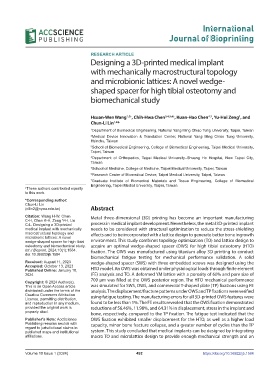Page 500 - IJB-10-1
P. 500
International
Journal of Bioprinting
RESEARCH ARTICLE
Designing a 3D-printed medical implant
with mechanically macrostructural topology
and microbionic lattices: A novel wedge-
shaped spacer for high tibial osteotomy and
biomechanical study
Hsuan-Wen Wang 1,2† , Chih-Hwa Chen 3,4,5,6† , Kuan-Hao Chen , Yu-Hui Zeng , and
1
4,7
Chun-Li Lin *
1,2
1 Department of Biomedical Engineering, National Yang Ming Chiao Tung University, Taipei, Taiwan
2 Medical Device Innovation & Translation Center, National Yang Ming Chiao Tung University,
Hsinchu, Taiwan
3 School of Biomedical Engineering, College of Biomedical Engineering, Taipei Medical University,
Taipei, Taiwan
4 Department of Orthopedics, Taipei Medical University–Shuang Ho Hospital, New Taipei City,
Taiwan
5 School of Medicine, College of Medicine, Taipei Medical University, Taipei, Taiwan
6 Research Center of Biomedical Device, Taipei Medical University, Taipei, Taiwan
7
Graduate Institute of Biomedical Materials and Tissue Engineering, College of Biomedical
Engineering, Taipei Medial University, Taipei, Taiwan
† These authors contributed equally
to this work.
*Corresponding author:
Chun-Li Lin
(cllin2@nycu.edu.tw) Abstract
Citation: Wang H-W, Chen Metal three-dimensional (3D) printing has become an important manufacturing
C-H, Chen K-H, Zeng Y-H, Lin
C-L. Designing a 3D-printed process in medical implant development. Nevertheless, the metal 3D-printed implant
medical implant with mechanically needs to be considered with structural optimization to reduce the stress-shielding
macrostructural topology and effects and to be incorporated with a lattice design to generate better bone ingrowth
microbionic lattices: A novel
wedge-shaped spacer for high tibial environment. This study combines topology optimization (TO) and lattice design to
osteotomy and biomechanical study. acquire an optimal wedge-shaped spacer (OWS) for high tibial osteotomy (HTO)
Int J Bioprint. 2024;10(1):1584. fixation. The OWS was manufactured using titanium alloy 3D printing to conduct
doi: 10.36922/ijb.1584
biomechanical fatigue testing for mechanical performance validation. A solid
Received: August 11, 2023 wedge-shaped spacer (SWS) with three embedded screws was designed using the
Accepted: October 13, 2023
Published Online: January 10, HTO model. An OWS was obtained under physiological loads through finite element
2024 (FE) analysis and TO. A deformed YM lattice with a porosity of 60% and pore size of
700 μm was filled at the OWS posterior region. The HTO mechanical performance
Copyright: © 2024 Author(s).
This is an Open Access article was simulated for SWS, OWS, and commercial T-shaped plate (TP) fixations using FE
distributed under the terms of the analysis. The displacement/fracture patterns under OWS and TP fixations were verified
Creative Commons Attribution using fatigue testing. The manufacturing errors for all 3D-printed OWS features were
License, permitting distribution,
and reproduction in any medium, found to be less than 1%. The FE results revealed that the OWS fixation demonstrated
provided the original work is reductions of 56.46%, 11.98%, and 64.31% in displacement, stress in the implant and
properly cited.
bone, respectively, compared to the TP fixation. The fatigue test indicated that the
Publisher’s Note: AccScience OWS fixation exhibited smaller displacement for the HTO, as well as a higher load
Publishing remains neutral with capacity, minor bone fracture collapse, and a greater number of cycles than the TP
regard to jurisdictional claims in
published maps and institutional system. This study concluded that medical implants can be designed by integrating
affiliations. macro TO and microlattice design to provide enough mechanical strength and an
Volume 10 Issue 1 (2024) 492 https://doi.org/10.36922/ijb.1584

